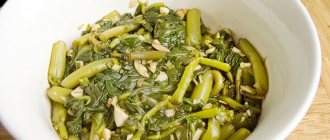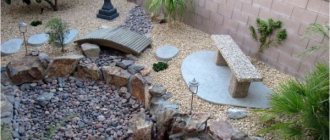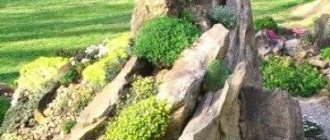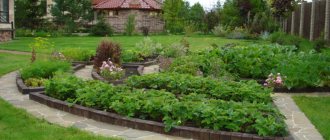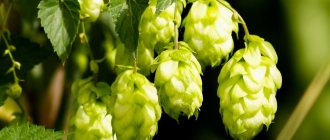Golden grass, warthog, jaundice - these are just three of the most common names of the celandine culture out of the many that exist. The plant, known for its healing properties and fully justifying its name, “lives” in the vastness of Ukraine, Russia, and Belarus. It can often be found in the Caucasus and even in distant Siberia. The distribution area of celandine is quite large, as are the methods of its use.
Celandine owes its healing properties to the presence of alkaloids in its composition - substances that can have a beneficial effect on various internal organs and systems of the human body.
There are about two dozen alkaloids contained in the grass. The root contains more biologically active substances than the above-ground part of the plant, but the leaves and stems also contain plenty of vitamins.
Celandine blooms in the last month of spring and continues to turn golden until mid-summer. But there is one trick that allows you to extend the flowering period of the plant. It is enough to cut the flowers before they wither - and then the healing representative of the flora will bloom again around the beginning of August.
Another feature of celandine is its unpleasant odor. It’s not worth trying the plant, because it tastes just as unpleasant. Most often, celandine is found in suburban areas and cottages, choosing shady places for growth along the fence or on the side of the house where a person steps as rarely as possible.
If you break the stem, bright orange celandine juice will immediately begin to flow out of the hollow inside. This feature is the main distinguishing feature of celandine.
Why are pests afraid of celandine?
Celandine is a poisonous plant that grows almost everywhere. Among all types of weeds, it fights best against harmful insects (aphids, whiteflies, spider mites, and so on). The secret to this lies in the insecticidal properties of its juice - just a few milliliters of this liquid is enough to prepare 5 liters of an antiparasitic agent. Well, if there are several celandine bushes growing on your site, then the pests will completely avoid it, since the stench from the poison interrupts even the sweet smell of juicy fruit crops. And celandine does not lose its properties after drying, so you can drive away uninvited guests with the help of weed bunches.
Top dressing
Liquid fertilizer from celandine is prepared as follows:
- dig up the plants by the roots, cut them into several parts;
- fold into a large plastic container up to half the volume;
- to fill with water;
- place in the sun for 2 weeks, stirring daily;
- strain before use;
- dilute with water in a ratio of 1:10;
- Before fertilizing, moisten the soil, and then apply fertilizer at the root;
- repeat the procedure once every 2 weeks.
The effect of this feeding is similar to that of manure.
Also learn about 5 plants that will keep weeds away from your yard.
A complete list of pests that are afraid of celandine
A natural insecticide based on celandine will be destructive for most known pests:
The famous roaring lion from MGM films has been completely replaced with graphics (video)
How to build a harmonious relationship: the secret of Yulia Kovalchuk and Alexey Chumakov
Russians turned their attention to Baikal, rediscovering it for themselves
- apple scale;
- click beetle (wireworm);
- thrips;
- white caterpillar;
- leaf roller;
- any type of aphid;
- flea beetles;
- spider mite;
- whitefly;
- cabbage fly;
- mole.
If your garden crops and plantings are threatened by rodents, you can also use a celandine-based product. True, it will be quite difficult to use it against animals hiding in the ground.
Weeding
An equally effective method, but just as effective if used regularly. In order to remove long vertical “carrot”-type rhizomes from the soil, you can use a special tool - a root remover, which is popularly called a “dandelion cutter”. The simplest modification is a long staple (resembling a half of a pipe cut along the length) with a sharpened end, mounted on a shaft. The point is driven into the soil so that the staple passes along the root, then a rotational movement is made, and the “rod” of the dandelion is easily removed from the ground.
How to prepare an infusion of celandine
The most effective remedy for combating annoying insects is an infusion of celandine. To prepare it, you need to prepare an armful of large plants in advance, without tearing off the roots, then properly chop the celandine, add it to a deep saucepan and pour 10 liters of hot water. After this, the folk remedy must be infused in a dark room for 24 hours. The strained infusion can be safely poured into a respirator and used to treat any vegetable and garden crops. This product will be most effective against aphids, whiteflies and other flying insects.
Types and varieties
the Asian celandine (Chelidonium asiaticum) is mentioned as introduced into culture but many experts consider it just a subspecies of the greater celandine, despite the fact that in 1982, on the basis of karyological and morphological analysis, it was separated into a separate type.
Also known is spring celandine, or forest poppy (Hylomecon vernalis = Hylomecon japonicum) , a perennial species with large bright yellow flowers, also belonging to the Poppy family, but representing an independent monotypic genus. Forest poppy is grown in cultivation as an ornamental plant.
- Echinacea: picking, optimal conditions for a flower
We disinfect the soil before planting bulbs using celandine
Before planting bulbous crops in the garden, it is strongly recommended to disinfect the soil. It is best to use an infusion of dry celandine for this - pour 150 grams of weed with 5 liters of boiling water and leave it in a dark room for 2 days. Before processing the garden, the broth must be filtered and then poured over the area, based on the calculation - 1 liter per 1 square meter. It is also recommended to use this product to treat the bulbs themselves before planting in the ground - it is not dangerous for the plant, but is a deadly poison for rodents.
Tatyana Arntgolts gave birth to a child, Mark Bogatyreva: first photo of the baby
Taking his friend’s wife away was the right decision: Pavel Maikov has been happy with her for 15 years
When you're tired of eggs: omelet roll with chicken and mushrooms for breakfast
Fighting the white butterfly caterpillar on cabbage
Have you noticed small damage on the cabbage leaves? Most likely, it is being attacked by a white butterfly caterpillar. However, do not rush to treat the area with a chemical insecticide, because after this the product will not be eaten for several weeks. The best option would be to use a decoction of fresh celandine. To prepare it, fill a metal container 1/5 with chopped weed, and fill the remaining volume with hot water. After this, you need to bring the product to a boil and cook for 15-20 minutes. Cool the resulting broth, filter it and use it to process cabbage.
Rodent protection
Rodents cannot tolerate the smell of celandine. This can be used to protect your area and home from mouse infestations. Sprigs of celandine are enough to be placed around trees and beds. It's good if you dry them first. You can also drive rodents out of your home. Even cats cannot stand the smell of this weed. If the neighbor's cats start messing around in the garden beds, celandine will help scare them away.
How to get rid of wireworms on potatoes once and for all
Wireworm larvae can be a real disaster for any farmer growing potatoes on his plot. However, a tincture of dried weed can also help here. To prepare a folk remedy, you need to infuse 500 grams of dry celandine with 10 liters of warm water, then infuse it for an hour. As soon as the water turns brown, the tincture must be filtered and used to water the young crop about once a week. It is also recommended to place several bunches of celandine around the perimeter of the area - this will repel insects in the future.
Bogdan Titomir lived three and a half years in America: how it affected him
Chicken cutlets with cherry tomatoes: signature recipe from actress Natalia Antonova
Greens, and Other Ways to Reduce Pollen Allergy Symptoms Without Drugs
Watering
From the beginning of the appearance of buds until the beginning of flowering, it is useful to water fruit and ornamental trees with an infusion of fresh weed. It's done like this:
- Pour 5 large bushes with 5 liters of warm water.
- Add 50 g of liquid laundry soap.
- Let stand in a warm place for 2 days (to enhance the effect, you can leave it for 5 days).
- Strain.
- Take the grounds to the compost, and use the resulting solution for watering.
Half a bucket is enough for one young tree. Celandine will destroy parasites hiding in the ground. The beds are treated in the same way before planting vegetables. To prepare the infusion, you can use dried preparations from last year.
A universal recipe for controlling other pests
Are the cucumbers in the greenhouse attacked by spider mites again? Are grapes suffering from thrips attacks? Have your tomatoes already started to turn black due to whitefly activity? Don’t worry, because a tincture of fresh celandine is designed to cope with almost any pest. To prepare it, you will need to collect 3-4 kilograms of plants, and then squeeze out as much juice as possible from them. Pour the yellow liquid into a bucket of water and use the resulting mixture to treat the plant affected by pests. It is recommended to carry out the treatment several times to ensure that all insects are killed.
How to effectively control pests in a greenhouse
To combat insects in closed ground conditions, it is not at all necessary to prepare tinctures or decoctions based on celandine. You can take several bunches of dry grass and simply set them on fire so that the room is filled with toxic smoke (observe safety precautions). Of course, before doing this, it is recommended to seal all the cracks so that the smoke does not escape into the street. After 12 hours, you can ventilate the greenhouse - not a trace of insects will remain. The only drawback of this method is that it does not kill pest larvae, so it is additionally recommended to treat the soil with celandine tincture.
“I know what really distinguishes them (sorry, us)”: Makarevich about Jews
Prigogine showed what Valeria eats for lunch: now the secret of her slimness has been revealed
EpiVacCorona will begin producing 10 million doses per month by the end of 2021
Green manure
This is the name given to crops that are planted for a short period of time in order to later be incorporated into the soil. This improves the soil structure (a system of root canals is created and it becomes looser), enriches the soil with nitrogen, and inhibits the growth of weeds. When you harvest, you are left with good, fertilized soil, which is instantly taken over by weeds. If you immediately sow green manure (rye, white clover, yellow lupine or mustard), the weeds will recede. As you can see, this agricultural technique kills several birds with one stone. The use of green manure, experts say, increases soil productivity by up to 40–50%.
What should you know before treating a crop with celandine?
Celandine should not be taken lightly, since this weed is still poisonous. Before preparing the infusion and treating plants against pests, be sure to read the safety rules:
- Wear protective gloves to avoid burning your hands from the poisonous juice. After work, be sure to wash them several times with soap.
- Make sure that celandine juice does not get on open areas of the skin, especially on wounds or cuts - it will not be pleasant.
- When preparing the tincture, be sure to cover it with a lid so that no pet or bird drinks the mixture.
- Before you start burning dry celandine in your garden, be sure to get safety glasses and a respirator.
You should also remember that the interval between treatments of green crops with celandine should not exceed 5-7 days, otherwise it may have a bad effect on the health of the plant.
Mulching
Celandine bushes are an excellent mulching material that not only helps get rid of some pests, but also suppresses the growth of weeds, and is also a source of useful substances. In addition, such mulch helps retain moisture in the soil.
You can use both freshly cut plants and dried ones. Fresh bushes are cut into several parts and spread thickly over the surface of the soil. You can prepare celandine for future use. This is done during its flowering period. It is dug up by the roots, dried in a place without direct sunlight in the open air and packaged.
